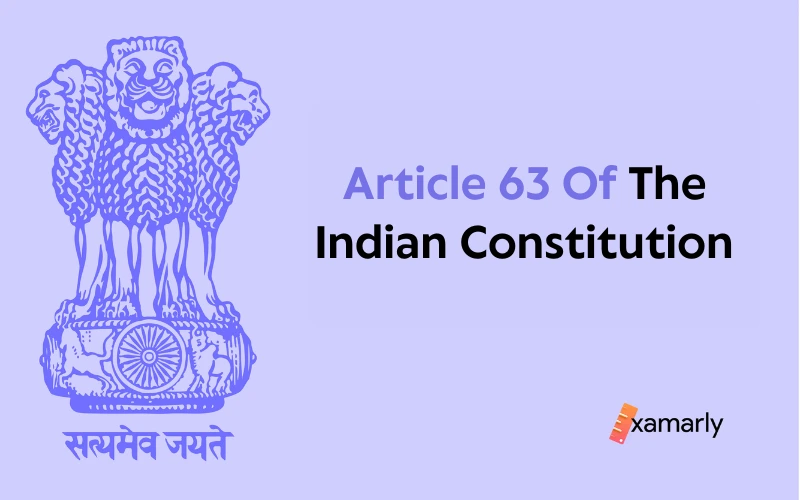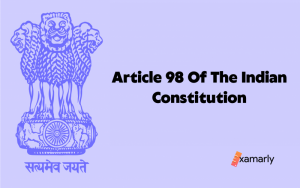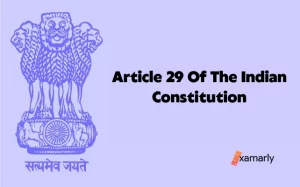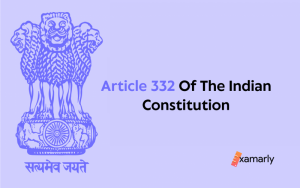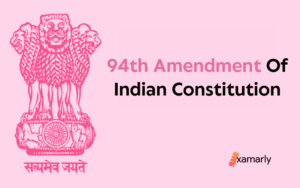Article 63 of the Indian Constitution found room in Part V under Chapter 1 “The Executive”. This article deals with the Vice President. The Vice President is chosen by the members of both Houses of Parliament in a joint session using a secret ballot and a single transferable vote in accordance with the proportional representation system.
Read the article further to figure out what Article 63 is all about.
- What Is Article 63 Of The Indian Constitution?
- Who Are The Vice President?
- Current Vice President
- List Of Vice Presidents Of India
- What Is The Dual Role Of A Vice-President?
- Vice President UPSC Facts
- Interesting Facts For Vice Presidents Of India
- Difference Between President And Vice President
- Conclusion
- FAQs
What Is Article 63 Of The Indian Constitution?
Article 63 States that India shall have a Vice President. This signifies that if the President is not present owing to a person’s death, resignation, impeachment, or any other circumstance, the Vice President of the country is required to assume the Presidency.
Who Are The Vice President?
The deputy to the head of staff of the Indian president is the vice president of India. The vice presidency is the highest constitutional position following the presidency, coming in second in terms of precedence and first in terms of succession. The vice president is a member of the Parliament of India and acts as the Rajya Sabha’s ex officio head.
Current Vice President
Since August 11, 2022, Jagdeep Dhankhar, an Indian lawyer and politician, has held the position of vice president of India.
He previously held the job of Governor of West Bengal before taking this one. During the Chandra Shekhar cabinet in 1990, he also served as the Union Minister for Parliamentary Affairs.
List Of Vice Presidents Of India
| Vice President of India | Term |
| Sarvepalli Radhakrishnan | From 13th May 1952 To 12th May 1957 |
| Sarvepalli Radhakrishnan | 13th May 1957 – 12th May 1962 |
| V.V. Giri | 13th May 1967 – 3rd May 1969 |
| Zakir Hussain | 13th May 1962 – 12th May 1967 |
| B.D Jatti | 31st August 1974 – 30th August 1979 |
| Gopal Swarup Pathak | 31st August 1969 – 30th August 1974 |
| Mohammad Hidayatullah | 31st August 1979 – 30th August 1984 |
| R. Venkataraman | 31st August 1984 – 24th July 1992 |
| Shankar Dayal Sharma | 3rd September 1987 – 24th July 1997 |
| Krishan Kant | 21st August 1997 – 27th July 2002 |
| K.R. Narayanan | 21st August 1992 – 24th July 1997 |
| Bhairon Singh Shekhawat | 19th August 2002 – 21st July 2007 |
| Venkaiah Naidu | 11th August 2017 – 10th August 2022 |
| Mohammad Hamid Ansari | 11th August 2007 – 11th August 2012 |
| 11th August 2012 – 11th August 2017 | |
| Jagdeep Dhankhar | 11th August 2022 – Till Date |
What Is The Dual Role Of A Vice-President?
The Upper House is under the control of the Vice President of India, who also performs some presidential duties. Additionally, the Vice President serves as the Council of States’ ex-officio chairman.
In this sense, the vice president of India fulfills these two roles.
Naturally, the holder of the two positions must shoulder a great deal of responsibility in light of these concerns. He needs to maintain the responsibilities of the two offices separate and distinct. These positions are extremely important because they both require making important decisions.
Additionally, no request for action that would conflict with his role as The Chairman may be made while he is fulfilling his duties as Vice-President. The Vice-President in India is a high-ranking position that requires them to perform a variety of roles.
Vice President UPSC Facts
Here are some essential points to remember regarding the vice president of India:
- The Indian Election Commission oversees the election for the post of vice president.
- In the 60 days following the expiration of the existing vice president’s term, the new vice president will be selected.
- Any candidate for the vice presidency who complies with the requirements for eligibility must receive the support of at least 20 MPs in both the proposer and seconder classes.
- Every applicant for vice president is supposed to deposit INR 15,000 as a security.
- The Supreme Court of India examines all questions and disagreements regarding the Vice-Presidential selection and then renders a final judgment.
Interesting Facts For Vice Presidents Of India
Here are some essential points to remember regarding the vice president of India:
- Sarvepalli Radhakrishnan was India’s first vice president. From 1952 until 1962, he served twice as India’s vice president. After fulfilling his first term, he was re-elected in 1957. He was originally elected in 1952.
- In 1962, S Radhakrishnan was chosen as the President of India after spending two years as Vice President. The first person to hold both the vice president and president positions in India was S Radhakrishnan.
- Mohammad Hamid Ansari is one of a total of 12 Vice Presidents of India who have served since the first Lok Sabha opened in 1952 and through the end of 2016.
- The position of President of India was upgraded and chosen from among 7 Vice Presidents. Krishan Kant, Gopal Swaroop Pathak, Mohammad Hidayatullah, B D Jatti, Bhairon Singh Shekhawat, and Hamid Ansari were the rest of six vice presidents.
- Only S. Radhakrishnan and Hamid Ansari have held the position of vice president of India twice(for two terms back-to-back). Between 2007 to2012, and then from 2012 to 2017, Hamid Ansari was India’s vice president.
- S Radhakrishnan, the former vice president of India (who eventually took office as president), is regarded as a renowned thinker, scholar, and philosopher, and is well-versed in Hindu culture. He also represented India at UNESCO.
- Two vice presidents of India have careers as bureaucrats rather than as politicians. They both began their careers in IFS (Indian Foreign Services). These two vice presidents are Hamid Ansari and K. R. Narayanan.
- K R Narayanan is the only Vice President of India to have wed a foreigner. He married Ma Tint Tint, a citizen of Burma, while he was still employed as an IFS officer. Later, she adopted the name, Usha Narayanan.
- Shankar Dayal Sharma is the only Vice President to have previously held the positions of Chief Minister of a state, Cabinet Minister, and President of the Indian National Congress.
- Bhairon Singh Shekhawat was the sole vice president who belonged to the BJP.
Congress-affiliated vice presidents of India include V. V. Giri, B. D. Jatti, Shankar Dayal Sharma, R. Venkatraman, and Krishan Kant. - Vice Presidents of India S Radhakrishnan, Mohammad Hidayatullah, Gopal Swarup Pathak, and Zakir Hussain were independent of any political party.
- Vice Presidents Gopal Swarup Pathak, Mohammad Hidayatullah, and R Venkatraman were all lawyers by trade.
- R. Venkatraman was the sole Vice President (who eventually became President) who served in the Constituent Assembly that created the Constitution.
- Zakir Hussain, vice president of India, co-founded Jamia Milia Islamia, a national Muslim university.
- Additionally, Zakir Hussain was the Vice Chancellor of AMU (Aligarh Muslim University).
- Bhairon Singh Shekhawat was the only Vice President to run unsuccessfully for President. He ran against Pratibha Patil in the presidential race.
Difference Between President And Vice President
| President | Vice-President |
| Head of the State of Indian Republic | Deputy to the Head of the State |
| All elected MLAs and all elected MPs from States. | Only MPs from both Lok Sabha and Rajya Sabha can vote. |
| Nominated members cannot vote in President’s election. | Nominated members can vote in Vice-President’s election. |
| Should be qualified for election as a member of Lok Sabha. | Should be qualified for election as a member of the Rajya Sabha. |
For Further Readings:
| Article 52 Of The Indian Constitution | Powers And Functions Of Lok Sabha and Rajya Sabha |
| National Leaders Of India | Asian Development Bank |
| Asian Infrastructure Investment Bank | Ashgabat Agreement |
Conclusion
On December 28, 1948, a discussion of the proposed Article 52 (Article 63 of the Indian Constitution) took place. There was simply a mention of India having a vice president. There was no meaningful discussion on this draft article. On December 28, 1948, the Legislative Assembly unanimously approved it. They did it without any changes.
FAQs
Article 63 Of The Constitution Is India Deals With What?
Article 63 of the Indian constitution refers to the existence of the Vice President in India.
Who Was The 1st Vice President Of India?
On May 13, 1952, Dr. Sarvepalli Radhakrishnan took the oath of office as India’s First Vice President.
Who Has Held The Vice Presidential Position In India For The Longest?
Dr. Sarvepalli Radhakrishnan and Mohammad Hamid Ansari have served as India’s vice president for the longest period of time.
How Long May The Vice President Serve As President For At Most?
Six months is the maximum time frame for Vice President to act as a President.


